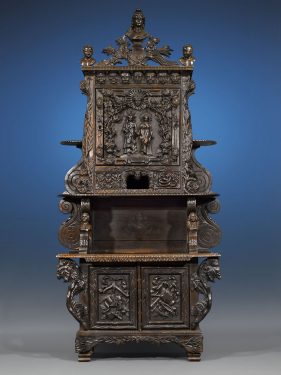Expositions are the timekeepers of progress. They record the world's advancement…These buildings will disappear; this creation of art and beauty and industry will perish from sight, but their influence will remain…
President William McKinley

International Exhibitions celebrate the world’s greatest technological advancements, bringing together the finest artistic and technological innovations from around the globe. Sometimes referred to as World’s Fairs, World Expositions, or Universal Expositions, these large public exhibitions promote innovation in art and design, international relations, and tourism.
Since the event’s inception, items displayed at International Exhibitions have consistently and unquestionably been the absolute finest examples of art and science. For an artist or craftsman, to be featured at an International Exhibitions represents both a remarkable honor and the unique opportunity “to see and be seen.” Notable artisans that have displayed their wares at International Exhibitions include the unrivaled ébéniste Francois Linke, the world-renowned, American silver firm Tiffany & Co., and architect Gustave Eiffel, who designed the Eiffel Tower especially for the 1889 World’s Fair! Likewise, the decorative arts on display have varied greatly in medium, shape, size, and function throughout the event’s 165 year history. The tour de force works have ranged from monumental furniture, like this intricately carved cabinet created for the Louisiana Purchase Exposition, to revolutionary porcelain, such as this Art Nouveau vase by Sevres revealed at the 1900 World’s Fair in Paris.
The very first International Exhibition was held in London’s Hyde Park in 1851. “The Great Exhibition of the Works of Industry of All Nations” or “The Great Exhibition,” as it is often called, welcomed over 6 million guests, including Queen Victoria herself. A designated structure, nicknamed the Crystal Palace, was constructed to house 13,000 exhibits. Popular items on display included pink diamonds, a Jacquard loom, kitchen appliances, and an exceptional micromosaic depicting the Roman Forum by Domenico Moglia. The inaugural International Exhibition was deemed wildly successful.
A mere decade after its launch, the exposition returned to England for the Great London Exposition of 1862. The exhibition showcased the advances of the industrial revolution with the electric telegraph, cotton mills, and the first plastic all on display. In addition, artistic achievements were well-represented and drew millions of visitors to the capital city. Among the exhibited decorative arts were an important silverplate charger created by Elkington & Co. and a monumental conical mystery clock crafted by Eugéne Farcot and Albert-Ernest Carrier-Belleuse.
For 165 years, International Exhibitions have continued to evolve, delighting visitors with the newest innovations of the day in locations ranging from Jamaica to Belgium and everywhere in between (even New Orleans)! While themes of environmental stability and cultural relations now prevail, their goal remains the same—to celebrate progress, to exhibit the best of the best.





